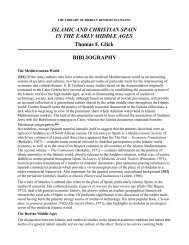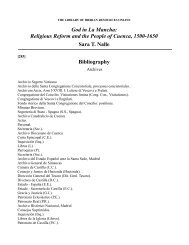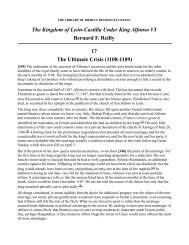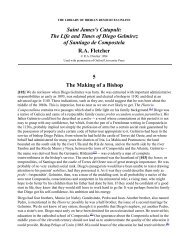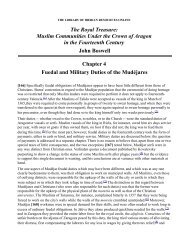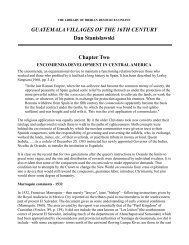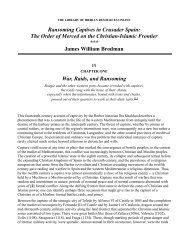The Cluniac Priories of Galicia and Portugal - The Library of Iberian ...
The Cluniac Priories of Galicia and Portugal - The Library of Iberian ...
The Cluniac Priories of Galicia and Portugal - The Library of Iberian ...
You also want an ePaper? Increase the reach of your titles
YUMPU automatically turns print PDFs into web optimized ePapers that Google loves.
enefactor, a close confidant <strong>of</strong> Count Henry. <strong>The</strong> donations then can be ascribed to a quite small circle<br />
consisting mostly <strong>of</strong> non-reigning members <strong>of</strong> the royal house <strong>and</strong> a few comital families, although<br />
subsequent grants to the priories disclose a much broader range <strong>of</strong> fervor for Cluny on less exalted<br />
levels. (110)<br />
(4) Of all the Luso-Gallegan acquisitions only Rates <strong>and</strong> Santa Justa were not already monastic<br />
communities at the time <strong>of</strong> transfer to Cluny. Although Henry <strong>and</strong> Teresa claim to have built the former<br />
from the ground up, the church was an ancient one; <strong>and</strong> Santa Justa had been an ecclesia before<br />
Maurice Bourdin converted it into a hospicium <strong>and</strong> gave it to La Charité. Teresa reconstructed but does<br />
not claim to have founded Vimieiro; <strong>and</strong> all six Gallegan donations were <strong>of</strong> existing monasterios<br />
propios. Except for San Martín de Jubia <strong>and</strong> (much less fully) San Vicente de Pombeiro, documented<br />
details <strong>of</strong> the abadengo each priory possessed are largely lacking, but the donors' allusions to<br />
heredades, terrae (cultae, populatae, incultae. non populatae), [336] meadows, vineyards, villages,<br />
churches, cotos <strong>and</strong> rights prove temporal endowments <strong>of</strong> some amplitude.<br />
A little light upon relative size <strong>and</strong> wealth is shed by (i) the incomplete surviving statistics for the<br />
amount <strong>of</strong> annual census each priory came to pay the mother abbey from the time <strong>of</strong> Peter the<br />
Venerable; <strong>and</strong> (ii) what came to be the fixed norm for the number <strong>of</strong> monks in each chapter. <strong>The</strong><br />
donation acts <strong>of</strong> Valverde, Budiño <strong>and</strong> Vimieiro specify a rate <strong>of</strong> one-half mark a year for the first two,<br />
<strong>and</strong> a full mark for Vimieiro, this last to be increased (to judge by other cases, perhaps doubled)<br />
following completion <strong>of</strong> its rebuilding. Such figures, running well below the 4 marks contemplated in<br />
1132 for Sahagún, the 10 gold florins paid by Carrión or the 5 marks <strong>of</strong> Nájera, can be compared with<br />
the st<strong>and</strong>ard size assigned each community, although these quotas must be used with caution since they<br />
have not yet been shown to date earlier than the middle 13th century. (111) Valverde at this time was<br />
supposed to maintain 4 monks, Budiño 6, Vimeiro 3, Pombeiro 8 (or 12), <strong>and</strong> Jubia 6, in contrast with<br />
the 25 <strong>of</strong> Carrión <strong>and</strong> Nájera's 30. (112) Correlation <strong>of</strong> these two types <strong>of</strong> data can be only approximate,<br />
since Vimieiro, for example, with only 3 monks, paid a higher census than Valverde or Budiño, with 4<br />
<strong>and</strong> 6 respectively. But these figures agree with deductions based on the diplomatic sources <strong>and</strong> on<br />
statistical comparisons with the abbey's other peninsular holdings, in presenting the Luso-Gallegan<br />
priories as by Hispano-<strong>Cluniac</strong> st<strong>and</strong>ards well-established communities <strong>of</strong> substantial wealth <strong>and</strong><br />
importance. None <strong>of</strong> them, even the larger, like Rates, Budiño, Jubia, Valverde, Vimieiro or Pombeiro,<br />
ranked with Carrión Dueñas or Nájera but they manifestly belonged to an intermediate class, well<br />
above the many communities <strong>of</strong> the Tierra de Campos <strong>and</strong> Rioja Alta that tended to become subpriories<br />
<strong>of</strong> the three foremost Hispanic daughters <strong>of</strong> Cluny.<br />
(5) In making their grants none <strong>of</strong> the donors mentions propagation <strong>of</strong> monastic reform as a motive, but<br />
esteem for Cluny's discipline <strong>and</strong> spirituality is implicit, <strong>and</strong> comes out strongly in Pedro [337] Froílaz'<br />
insistence that Jubia's prior always be a senior monk from the mother house, trained in her customs <strong>and</strong><br />
learned in the Scriptures, although the subprior might be drawn from an obedientia. (113) But it is <strong>of</strong><br />
course the note <strong>of</strong> liturgical intercession that is most frequently sounded, <strong>and</strong> obviously not merely as a<br />
commonplace <strong>of</strong> medieval ecclesiastical donations but out <strong>of</strong> a deep regard for Cluny's renown as a<br />
center <strong>of</strong> such intercessory prayer. Henry <strong>and</strong> Teresa expect to be remembered in the orisons <strong>of</strong> the<br />
religiosi uiri inhabiting Rates, while Maurice Bourdin looks to the monachornm orationes at both La<br />
Charité <strong>and</strong> Cluny. Counts Pedro Froílaz <strong>and</strong> Gómez Núñez expect that the <strong>Cluniac</strong>s placed in their<br />
erstwhile familial monasteries <strong>of</strong> Jubia <strong>and</strong> Budiño will continue to pray for their souls <strong>and</strong> their<br />
kinsmen's. (114) And Queen Teresa, in the most detailed <strong>of</strong> such provisions, stipulates when ceding<br />
Vimieiro that she is to be associated henceforth with the merits <strong>and</strong> prayers <strong>of</strong> all <strong>Cluniac</strong> obedientiae<br />
as well as <strong>of</strong> the abbey herself, <strong>and</strong> after death to receive a tricenarium <strong>of</strong> Masses <strong>and</strong> perpetual<br />
commemoration <strong>of</strong> her obit. (115)



